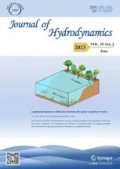Abstract
The effect of reducing cavitation damage in high-speed flow structure not only relate with entrained air concentration, but also relate with air bubble density has been discovered in recent research. The air bubbles in aerated flow with diameter below then 0.2mm or 0.5mm plays important role in reducing cavitation damage. May be very little air concentration can protect construction free from cavitation erosion. Thereby, measuring bubble size must be emphasized in study of reducing cavitation damage. Measuring bubble size can use probe of needle-type and image usually. By analyses and application experience of velocimeter of air concentration probe of needle-type, suggesting of the median size of bubble d 50 adopt measuring data by probe directly, and calculate space distance and density of bubble. Although, the d 50 and space distance would be big then real size, and density small then real value. The measuring results have importance value for studying mechanism and establishing a new criterion on entrained air to reduce cavitation damage.
Similar content being viewed by others
References
LI Wei-xing, hydraulics Prototype observation of LUBUGE hydraulic power flood discharge tunnel at left side bank. [C]. Discharge engineering and high speed flow memoir, 1994, 45-48. (in Chinese)
CHEN Xian-pu, XI Ru-ze, SHAO Dong-Chao, and CHAI Gong-Shun, New Direction of Study on Entrain Air to Reduce Cavitation Damage. [J]. Water resources and hydropower engineering, 2001, 10: 13–16. (in Chinese)
CHEN Xian-pu, XI Ru-ze, SHAO Dong-Chao, and LIANG Bin, New concept of air entrainment effect on mitigating cavitation damage. [J]. journal of hydraulic engineering, 2003, 8:70–74.
LIANG Bin, CHEN Xian-pu, SHAO Dong-Chao, and CAI Hua, Air bubble gradation of high velocity aerated flow.[J]. Hydro-science and engineering, 2002.6, No.2, 66–68. (in Chinese)
ZHANG Fa-xing, XU Wei-I in, ZHU Ya-qin, and ZENG Hua, Effects of bubble size distribution on aeration for cavitation alleviation under cavitation shock wave. [J]. Water resources and hydropower engineering, 2005, 10: 5–7. (in Chinese)
LI Zhi-gao, CHEN Gang, HUANG Zhao-wei, and ZHANG Ming-liang. The effect of bubble diameter on entrainment concentration forecast result. [J]. journal of Northwest hydroelectric power, 2004, Vol. 20, 1: 4–6. (in Chinese)
CHEN Xian-pu, CAI Hua, XI Ru-ze, LIANG Bin, SHAO Dong-Chao, and CHAI Gong-Shun, A air concentration velocity meter with the probe of needle type. [C]. Hydraulics measurement technology memoir, Vol. 4: 37-42. (in Chinese)
SHAO Dong-Chao, CHEN Xian-pu, XI Ru-ze, and CAI Hua, Experimental of aerated flow in flood discharge tunnel. [J]. Water resources and hydropower engineering, 2001, 10: 29–31. (in Chinese)
Liu Chao, and YANG Yong-quan, Study of mitigating cavitation erosion on turn over arc downstream sidewall in dragon look up free flow flood discharge tunnel. [J]. Water resources and hydropower engineering, 2003, 9: 26–28. (in Chinese)
CHEN Xian-pu, SHAO Dong-Chao, Yu Zhi-Liang, and LIANG Bin, Experimental Study of Flow behavior of Air Entrainment, [R]. Anhui & Huaihe River Water Resources Research Institute, 2006.2. (in Chinese)
ZHANG Rong-sheng, ZHENG Yuan, and CHENG Yun-shah, Study of measuring micro-bubble diameter. [J]. Journal of Experiments in Fluid Mechanics, 2005.6, Vol.19, No.2, 91–95. (in Chinese)
GONG Wei-jin, CAI Jian-an, and LI Ling, The Use of Computer Image Processing Technology in Studying Characteristics of Air Bubbles in Air Floatation Process. [J]. Industrial water & wastewater, 2004.12, Vol. 35, No.6, 60–62. (in Chinese)
LIU Rong-li, DAI Guang, and CHEN Gang, Application of Digital Image Technique in Measurement of Bubble Void Fraction. [J]. Journal of SICHUAN university (engineering science edition), 2003.1, Vol.35, No.1, 24–26. (in Chinese)
Author information
Authors and Affiliations
Corresponding author
Additional information
Project supported by the National Natural Science Foundation of China (Grant No: 50279022).
Biography: CHEN Xian-pu (1939-), male, Professor.
Rights and permissions
About this article
Cite this article
Chen, XP., Shao, DC. Measuring bubble size in aerated flow. J Hydrodyn 18 (Suppl 1), 459–463 (2006). https://doi.org/10.1007/BF03400489
Published:
Issue Date:
DOI: https://doi.org/10.1007/BF03400489


